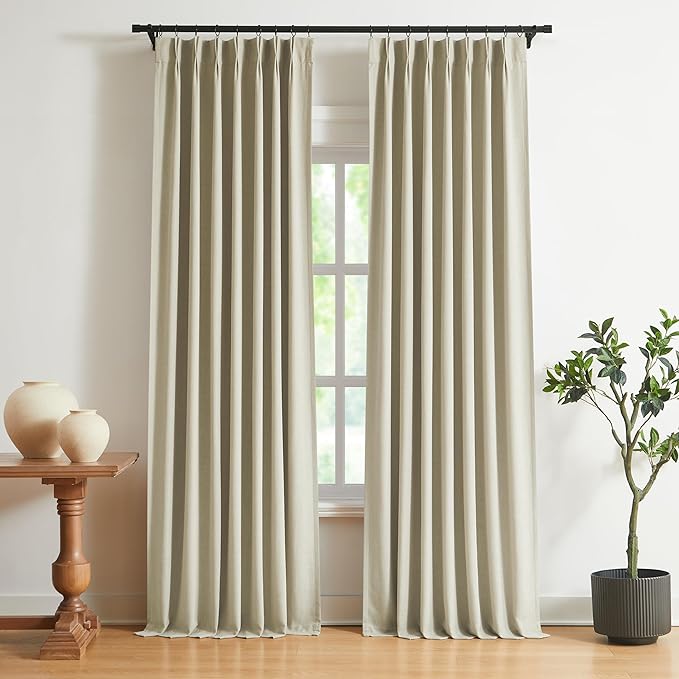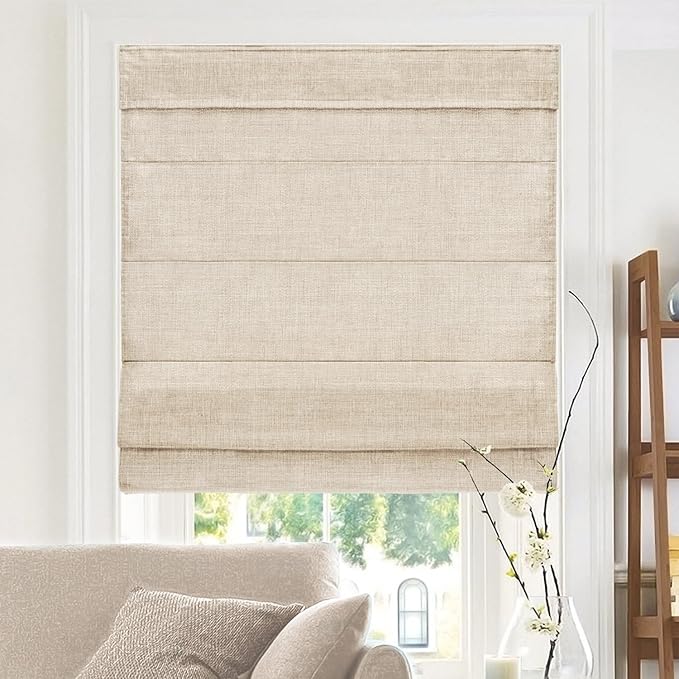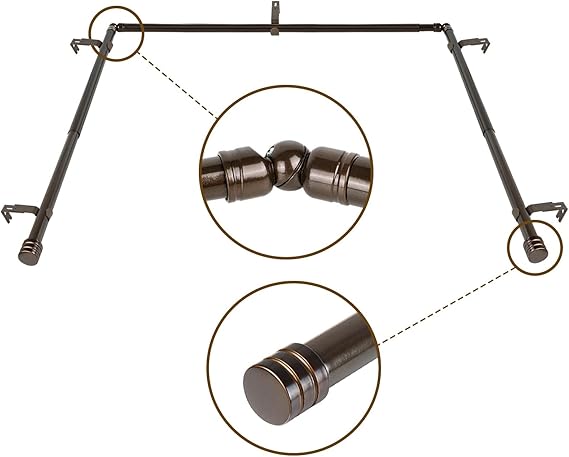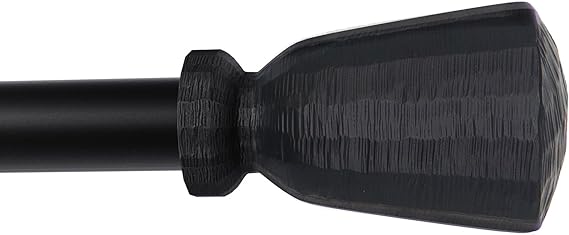Drapery can significantly transform the look and feel of any room, adding elegance, warmth, and personality. Whether you’re revamping your living room, bedroom, or office space, mastering the art of drapery can truly elevate your interior design game. Here are some expert tips to help you take your drapery to the next level.

This post may contain affiliate links, meaning I could earn a small commission if you make a purchase through my link, at no extra cost to you. You can read my full disclosure here. Thank you for supporting Alagu Home!
Differences Between Drapes for Privacy and Style
When selecting drapes, it’s essential to consider their primary purpose: privacy or style. For privacy-focused areas like bedrooms or bathrooms, opt for heavier fabrics or blackout liners that provide maximum light control and insulation.
For style-driven spaces such as the living room or dining area, prioritize aesthetics with sheer or lightweight fabrics that filter natural light while adding texture and visual interest.
The Importance of Scale and Proportion in Drapery Selection
Proper scale and proportion of drapes in relation to the room are paramount for achieving a harmonious and visually pleasing aesthetic. It’s essential to consider the room’s dimensions, ceiling height, and overall design scheme when selecting drapery. Opt for floor-to-ceiling panels to elongate the space and create a sense of grandeur, particularly in rooms with high ceilings.
Additionally, ensure that the width of the drapes extends beyond the window frame to allow for full coverage when drawn closed, enhancing both privacy and insulation. Avoid overwhelming smaller rooms with excessively heavy or voluminous fabrics, opting instead for lighter materials and streamlined designs to maintain a balanced and proportional look.
Choosing the Right Fabric
Selecting the perfect fabric is crucial in achieving the desired aesthetic and functionality for your drapery. Consider factors such as the room’s purpose, sunlight exposure, and desired ambiance. Opt for light and airy fabrics like linen or sheer for a breezy, casual look in spaces like the living room or kitchen. For a more formal atmosphere, velvet or silk fabrics can add a touch of luxury and sophistication to your drapes.
Choosing the Right Finishing and Hanging System
The finishing and hanging system play a significant role in the overall appearance and functionality of your drapery. Invest in high-quality hardware such as decorative rods, rings, or tracks that complement your interior style.
Additionally, consider the type of pleating or folding technique that best suits your space, whether it’s traditional pinch pleats, modern grommets, or sleek ripple folds.
Keep reading to explore expert tips for drapery that will elevate your space, bringing sophistication and style to your home décor effortlessly.
Layering Blinds and Curtains for a Luxurious Feel
Layering blinds or shades with curtains adds depth, texture, and versatility to your window treatments. Start by installing blinds or shades for practical light control and privacy, then layer sheer or lightweight curtains for softness and dimension. This combination not only enhances insulation but also creates a luxurious and visually appealing window treatment.
Drapery Around a Sliding Door
Draping around a sliding door requires careful consideration to ensure functionality and aesthetics. Opt for drapery panels with grommets or rings for easy maneuverability along the track. To prevent interference with the door’s operation, choose lightweight fabrics that won’t obstruct movement. Consider installing tension rods above the door frame for a streamlined look and hassle-free installation.
Drapery Around Arched Windows
Draping around arched windows requires careful planning to accentuate their unique shape and architectural features. Opt for custom-made drapery panels or flexible curtain rods that follow the curvature of the window for a tailored fit. Consider installing stationary panels on either side of the arch to frame the window and enhance its visual appeal while allowing natural light to filter through.
Keep reading to discover expert tips on elevating your space with exquisite drapery solutions, taking your home décor to the next level with sophistication and style.
Drapery in Bay Windows
Bay windows offer a picturesque backdrop for drapery, enhancing their architectural charm and creating a cozy nook for relaxation or entertaining. Install ceiling-mounted tracks or rods to maximize space and accommodate the bay window’s angles. Opt for lightweight fabrics and minimalistic designs to maintain an open and airy feel while highlighting the window’s panoramic views.
When to Use Pattern on Drapes
Incorporating patterns into your drapery can infuse personality and visual interest into your space. Opt for bold patterns in large rooms to make a statement or in smaller spaces to create a focal point.
However, be mindful of the room’s existing decor and color palette to ensure harmony and balance. Consider using patterned drapes as an accent to complement solid-colored furniture or walls.
How Often Should You Change Drapes?
The frequency of drapery changes largely depends on personal preference, lifestyle, and seasonal trends. While some may opt for seasonal updates to refresh their space, others may prefer timeless designs that withstand the test of time.
Consider changing drapes every few years to adapt to evolving tastes or decor trends, or as needed to maintain freshness and functionality.

Steaming, Training, and Washing Your Drapes
Proper care and maintenance of your drapes are essential to preserve their quality and appearance over time. Steaming and training your drapes ensure they maintain their intended shape and drape beautifully. Even the most expensive and custom-made drapes can appear cheap and frumpy if neglected. Steaming helps remove wrinkles and creases, restoring the fabric’s smoothness and luster.
Additionally, training your drapes involves arranging and shaping them to hang evenly and gracefully, enhancing their overall elegance and sophistication. While regular steaming and training are crucial, drapes should also be washed once in a while to remove dust, dirt, and any buildup that may affect their appearance and longevity. Incorporating these maintenance practices into your routine not only prolongs the lifespan of your drapes but also contributes to a polished and refined interior aesthetic.
Keep reading to uncover expert tips for drapery that will transform your space, adding a touch of elegance and style to your home décor.
Budget-Friendly Drapery Solutions
Achieving stylish drapery doesn’t have to break the bank. Explore budget-friendly options such as ready-made curtains, DIY embellishments, or repurposed fabrics to achieve a custom look without overspending.
Additionally, prioritize investing in quality hardware and essential fabrics while saving on decorative elements or accessories that can be easily updated or replaced over time.
Rooms Where You Can Cut Costs on Drapery
While drapery is an essential element in interior design, there are rooms where you can prioritize cost-effective solutions without compromising style or functionality. Consider allocating more budget to high-traffic areas like the living room or bedroom, where quality drapery can make a significant impact on comfort and ambiance. In less frequented spaces such as guest rooms or home offices, opt for budget-friendly options or DIY alternatives to achieve a polished look on a smaller budget.
Final Thoughts
Mastering the art of drapery involves thoughtful consideration of fabric, hardware, and design elements to achieve a cohesive and stylish look. By following these expert tips for drapery, you can elevate your space and create a truly personalized and inviting atmosphere that reflects your unique taste and lifestyle. Whether you’re dressing up a sliding door, bay window, or arched window, drapery offers endless possibilities for enhancing the beauty and functionality of your home.























